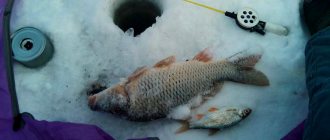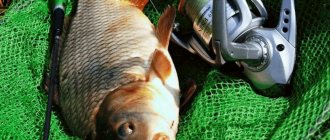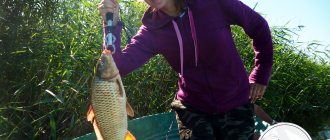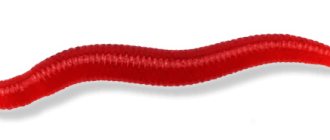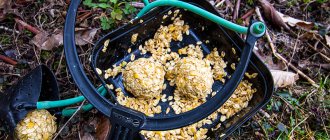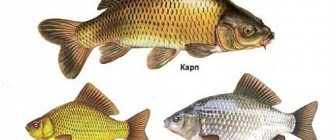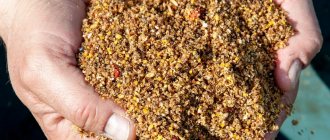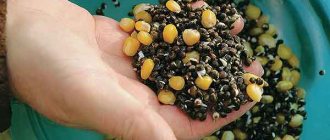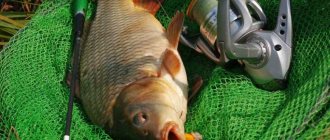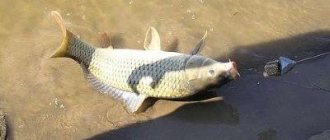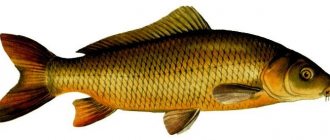Features of carp fishing at night
Night carp fishing has a number of advantages over fishing during daylight hours:
- On many reservoirs, during the swimming period, it becomes noisy during the day due to vacationers and swimmers. At the same time, the cautious carp refuses to feed during daylight hours. Night in this case remains the only time when it is possible to catch carp, especially trophy specimens with a small concentration in the pond.
- At night, the carp is more active, since it is not frightened by extraneous noises ; it comes closer to the shore, actively combing the reservoir in search of food.
- In the dark, carp look for food, relying only on their sense of smell . At the same time, he will not be alarmed by the fishing line and other visible parts of the tackle.
However, carp fishing at night is complicated by some inconveniences:
- Limited visibility. In the dark it is more difficult to make an accurate cast, as well as to bring out large specimens of carp.
- Additional equipment and equipment required
- At night, mosquitoes are very annoying near the water .
- It is necessary to prepare the fishing site in advance - as a result, night fishing requires a significant investment of time.
Ichthyology
Carp is the same carp. It is not for nothing that its Latin name “Cyprinus carpio” can be translated as “Cyprin carp”, and Wikipedia, beloved by many, does not divide them into two species, but devoted one article to both.
However, there are still undoubted differences between them.
Here's what you need to know: Cod fishing in the Barents Sea
Outwardly, it looks like domestic carp, but differs in several ways:
- more driven strong body;
- lack of decorative forms;
- growth arrest after 7-8 years of age.
At the same time, the carp grows to impressive sizes. According to unconfirmed data, the heaviest specimen caught weighed 55 kilograms. Sometimes when fishing you come across large trophies under 20 kilos and more than a meter long. The usual specimens in catches are fish weighing 3-12 kilograms.
Appearance
This beautiful, strong fish has dense yellow scales that completely cover its body. On the back the color is much darker, it can turn into bluish-black, the belly is slightly lighter than the sides.
When is the best time to fish at night?
Night carp fishing is possible from June to October, but it is most successful during the hottest time of the year . During the day, the water heats up to the maximum temperature at which the carp stops feeding, and at such times you can often observe swimming carp, which remain active, but completely refuse the offered bait. The only way out is to catch carp at night, when the water temperature drops somewhat and the fish’s appetite awakens.
Fishing by season
Catching carp in the spring begins even before spawning. By the way, this is not a successful enterprise in all reservoirs due to the migration of fish. Often the fish begin to feed only near the spawning grounds and this happens in a very short period.
Short-term zhor begins a couple of weeks after spawning and lasts about ten days. Later during the summer, the best time for fishing for carp, it bites more or less evenly.
Autumn fishing is also marked by a surge in activity. Around the end of August or beginning of September, the fish become more active and feed heavily, gaining fat for the winter. This lasts until the weather gets colder and the water clears in October-November.
Autumn carp is one of the desired trophies for fishermen who respect the fight against a strong opponent. In terms of beauty and frequency of somersaults and candles, this fish can easily compete with pike.
In winter, carp mainly rest in wintering pits, rising from them only during prolonged thaws or before the opening of reservoirs, when they can be accidentally caught as by-catch when fishing for crucian carp or bream.
Selection and preparation of a site
In stocked cultivated ponds, where the number of carp is large, choosing a place is not particularly difficult, but in conditions close to natural, you need to take care of preparing and choosing a place for carp . Since it is quite difficult to decide on a place at night, you should worry about this before dark.
The carp’s favorite places remain sharp changes in depth, the boundaries of vegetation and a clean bottom, as well as snags , but at night carp can swim close to the shore, so you should pay attention to similar places in the coastal zone. Also, in the dark, carp can swim to feed in smaller places - up to 0.5-1 m, especially on quiet, windless nights. In windy weather, as a rule, the carp remains at depth.
It is very important to clear the shore of grass and tree branches in which the fishing line can get tangled when preparing the tackle, casting and landing fish. If the bottom of a reservoir in the coastal zone is abundantly overgrown with algae, it is better to remove them in advance.
You also need to take care of unhindered access to gear , if you plan to spend the night in a tent or vehicle - you need it to be located as close as possible to the gear without obstacles on the way to it. There should also be a “first aid kit” on hand to quickly repair gear in case of a break.
Animal baits for catching carp
Home > Fishing techniques > Animal baits for catching carp
Dung beetle - this worm is also a universal attachment for carp. If you want to catch a large specimen, put a dozen or more small dung worms on the hook to create a “live” lump the size of a large plum. A small bait of 1-2 worms is mercilessly plucked by ruff, perch, and roach.
Maggot is a universal and very good attachment. To give maggots a special aroma, they can be kept in garlic, vanilla, or ground seeds. Usually 5-6 or more pieces are put on a hook. The only drawback of the nozzle is that small numbers of hooks are required.
The subleaf is also used as a bait. Five or more pieces are put on the hook.
The crawler is a good bait for carp and other large fish. This attachment is best used in currents and deep places. The preferred time of day for fishing is warm, moonless nights. The reason is simple - at this time the worm usually appears on the surface and is often washed into rivers by heavy rains.
The earthworm is durable, but very sluggish. In warm water it quickly dies. Carp takes it well in the spring, when there is still little food. Usually 3-4 pieces are attached to a hook.
Dracena, pearl barley, coils, pond snails, etc. Carp usually hunt for shellfish meat in the spring and closer to autumn. In summer, where there is a good food supply, it is rarely tempted by this bait. The best sign of feeding reservoirs is well-developed aquatic vegetation.
Pieces of raw fish (“cut”). The carp usually takes to “cutting” in the spring or closer to autumn and only during the current. In my practice, large carp attacked it only at night in the middle reaches of the Amu Darya and Syr Darya.
When trying to fish with this bait in the Don basin, I did not achieve positive results.
Shitik is the larva of a nocturnal caddisfly moth. Builds a little house out of twigs and grains of sand. Crawls along the bottom or sits, clinging to underwater objects. Shitik's color varies from white to gray-green. Shitiki live in clean streams, small rivers, and are often found in lakes. Shitik is a very good bait for carp, but he rarely gets it. It is a delicacy for rudd, roach, chub and other fish. Usually 5-6 larvae are put on a thin hook.
The mole cricket is a southern large winged insect (up to 6 cm). It looks like a scorpion, only without the long curved tail. Or with the help of strong front pincer paws, it digs holes very well. The color of the mole cricket varies from yellowish to almost black, depending on the color of the soil. The mole cricket loves loose, moist soil, in which it hides during the day. At night she is attracted by the light of a lantern. Collecting it is simple - hang a sheet and a lantern in front of it: the mole cricket flies into the light, hits an obstacle and falls to the ground, where it is collected.
Medvedka is an excellent summer bait for river carp and barbel catfish. Before you put it on the hook, you need to tear off the front pincer legs. It is best to fish with donkeys at night and in the current. As a rule, only large carp take on mole crickets.
Cancers. For bait, choose the smallest crayfish that have just molted. Carp are usually caught using crayfish at night and in the current. Moreover, it is better to cast the bait close to the shore. Optimal depths up to 1.5 m.
The omentum is a large larva of the May beetle. Reaches a length of 30-50 mm. The thick body of the larva is curved in an arc, its posterior end is thickened, sac-like and usually looks bluish-gray (the contents of the hindgut are visible). The head of the larva is large, smooth, yellow-brown.
In the spring, when the earth begins to warm up, the omentum moves into the upper layers of the soil and eats the roots of young plants. With the onset of cold weather, it goes to a depth of 1.5 m and hibernates. ,
It is best to look for omentum in young tree plantings, digging up the soil near yellowed, wilted plants. They are placed on hooks from 1 to 10 from the head, passing the sting to the load in the tail. To prevent the seal on the hook from turning black, you need to open the back of the larva before baiting and squeeze out the intestinal contents. The best time for fishing with the seal is spring and early summer.
Locusts are a good bait for carp in the summer. It is suitable for both bottom and top fishing. To catch large fish, individuals with a size of 40-50 mm are selected. Place it on a hook, piercing the chest under the head and bring the sting out in the lower part of the abdomen.
Dragonfly larva (sometimes called “devil”). To catch carp, the largest larvae of the rocker dragonfly are collected. The larva reaches 5-6 cm. It is not difficult to get them. To do this, you need to grab a bunch of elodea or hornwort with your hands and quickly pull it out of the water. Along with the plants, the larvae will also be captured. The best time to catch carp on the “devil” is spring and early summer during the period when dragonflies emerge.
Malek . The carp hunts for fry mainly in late summer and autumn. Most often, when juveniles gather in large flocks and prepare for wintering. They are usually caught with bottom rods in a weak current.
Equipment
Night fishing for carp cannot be done without additional equipment.
In order to prevent the carp from leaving the hook when bringing the fish to the shore, you should prepare a landing net , which should be wide enough so as not to miss in conditions of limited visibility.
Particular attention should be paid to lighting - when fishing for fish, you will definitely need lighting. In this case, it is advisable to have two flashlights, even if you plan to fish alone.
Night is the time when midges are active, so you need to prepare anti-mosquito products , otherwise fishing may remind you of itself for a long time with itchy bites. You should also not forget that at night the temperature can drop significantly, so it would be a good idea to take warm clothes with you .
It would be a good idea to set up a tent in the evening in case of rain. Important! Experienced fishermen advise using a flashlight with a red filter when fishing for carp, while when illuminating the camp, you can use a regular LED one. The red light does not scare the carp, and it behaves more calmly when approaching the shore.
What gear to fish with at night
The following gear is best suited for catching carp and carp at night:
- Feeder . Classic tackle for carp fishing at night.
- Match fishing rod . It is most often used on short casts, since following a small point in the distance is very tiring for the eyes.
- Flying float rod . At night, carp often come close to the shore, but when fishing this way, silence should be strictly observed.
Bite alarms
Of great importance is the correct selection and configuration of bite alarms for night carp fishing . When setting up an electronic bite alarm, you should remember that in the silence of the night a loud sound can frighten the carp. It is also advisable for the light from the alarm to shine on the fishing line to determine whether it is unwinding and at what speed.
For match fishing rods, you can use luminous floats, but their light should also not be bright, especially when fishing in a reservoir with clear water.
Attention! Illuminating the floats with a regular flashlight is highly undesirable, as this will scare away the carp.
How to choose gear for carp
Groundbait and bait
The bait mixture for carp is made from the same ingredients as in the daytime - for example, a base of corn flour, breadcrumbs, cake, bran, oatmeal, semolina in various proportions, to which flavorings are added - honey, garlic, anise oil and others.
But some difficulties may arise with the delivery of bait to the place of casting, since in the dark it is quite difficult to throw bait balls exactly into the place of the previous bait. Therefore, it is recommended to deliver complementary foods using a radio-controlled boat or slingshot.
Reference! Since in the silence of the night the sound of throwing bait can frighten the fish, it is recommended to make the starting bait before dark, and throw the rest of the bait after when the bite subsides.
As for baits, in hot weather in summer the carp prefers plant baits. Canned corn, peas, pearl barley or steamed corn work well. Boilies give excellent results - and for night carp fishing, it is not the color of the bait that is decisive, but its smell. When fishing with animal baits, which are more relevant as cold weather approaches, preference should be given to those that are present in the natural diet of carp in a given body of water - these are bloodworms, leeches, crustaceans, and worms.
- Bait for carp and carp
- How to prepare bait for carp with your own hands
Night fishing tactics and techniques
First of all, you should take care of choosing a landmark with which to re-cast the gear. These can be either luminous objects on the opposite bank or buoys specially abandoned for these purposes, equipped with reflective elements.
On the first cast, you need to leave a mark on the fishing line with a waterproof marker or marking thread, so that during subsequent recasts you will get to the baited area.
When preparing the site and starting feeding the carp, it is recommended to measure this distance , and then drive two pegs near the fishing site at a distance of a meter from each other. In the event of a gear break, this will help to quickly restore the marker to the required place after the gear is restored.
After hooking, you should, if possible, immediately move the carp away from other abandoned gear, since unraveling the gear in the dark can completely disrupt the entire fishing trip. When fishing, you should focus not on the fishing line, but on the tip of the rod - it will more accurately indicate the location of the carp.
Adviсe
- It is best to go night fishing in a group of two or more people, since assistance is often required in the dark, especially when landing trophy carp.
- Carp is a very cautious fish, so smokers should cover the light with a match or lighter.
- It is not recommended to use a flashlight again, not only for the reason that you can scare the carp - after the bright light, the eyes will get used to the darkness for a very long time.
- Even in moonlight, you should take care of visual camouflage - the silhouette of a fisherman above the water may not go unnoticed by the carp.
- Bait and bait for carp should be located in places inaccessible to rodents, which are much more active at night.
We use boilies
Today this is the most effective way of fishing. The likelihood of meeting our ward is high. You need to use boilies with a diameter of up to 2.5 cm. It is not recommended to use balls with strong odors (garlic, vanilla, anise). You can buy the finished product at any specialized fish store, where you are provided with a wide selection. In addition, there is the opportunity to consult with the seller, who, most likely, is an avid fisherman himself.
Catching carp page
will reveal to you all the details of such fishing.
